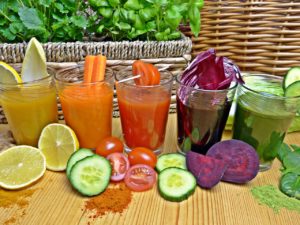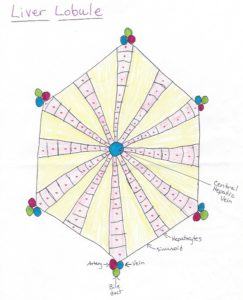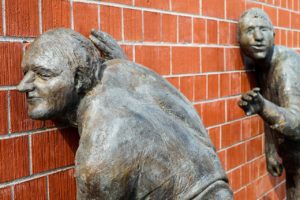Liver Lesson #6: Immunity [Show Notes]

Let’s Review
Liver contributes to:
1. Digesting your food
2. Metabolizing the energy from your food
3. Storage of Vitamins
4. Detoxing waste and toxins from your blood
5. Production of factors involved in blood clotting
Lastly, your liver keeps your healthy by aiding your immune system.
This is the last time we get to see this guy! *sad*

Sinusoids of Immunity
The last part of the lobule to be discussed is the sinusoids. Sinuses and sinusoids describe the space between (think about the sinuses in your your face – they are actually just holes and tubes through the bones of your face and skull that allow for empty space).
Sinusoids are lined with Kupffer cells (actually pronounced “Coop-fur”; I said it wrong on the broadcast – blame it on the accent). Kupffer cells are a part of your immune system (remember that your immune cells flow through the lymph system that parallels your blood vessels). Some of the cells involved in your immune system are called macrophages (big eater). When they find something that’s not supposed to be there, they gobble it up and carry it off to be disposed of or dissolve it into it’s basic parts and makes it safe.
Summary
Kupffer cells are macrophages that are stationed in the sinusoids of your lobules of your liver.
So, if you’ve had an infection and you start to get better, where do all the dead bacteria go? They end up floating around in your blood and the Kupffer cells will gobble them up. Kuppfer cells will do this for bacteria, fungi, and micro-parasites that they encounter. They also gobble up dead red blood cells and get them out of circulation. Other types of cells in your body die periodically and they, too, get gobbled up by Kupffer cells and have their parts recycled.
Dying cells and bacteria can release toxins if you had to wait on them to break down and dissolve on your own.
The liver is very efficient at all the things it does. Without your liver, processes that help your body thrive would take too long for you to reap the benefits.
Connect with me
Support us on Patreon
*NEW* Join the Pharmacist Answers Podcast Community on Facebook
Subscribe: iTunes, Stitcher, GooglePlay, TuneIn Radio

